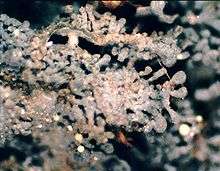Isidium
An isidium is a vegetative reproductive structure present in some lichens. Isidia are outgrowths of the thallus surface, and are corticated (i.e., containing the outermost layer of the thallus), usually with a columnar structure, and consisting of both fungal hyphae (the mycobiont) and algal cells (the photobiont). They are fragile structures and may break off and be distributed by wind, animals, and splashing raindrops.[1] In terms of structure, isidia may be described as warty, cylindrical, clavate (club-shaped), scale-like, coralloid (coral-shaped), simple, or branched.[2]
Examples of isidiate lichens include members of the genera Parmotrema and Peltigera.

C. palmicola photographed through a dissecting microscope (x40) showing isidia.
See also
References
- ↑ Blackwell, Meredith; Alexopoulos, Constantine John; Mims, Charles W (1996). Introductory Mycology. New York: Wiley. ISBN 0-471-52229-5.
- ↑ Bisby, Guy Richard; Ainsworth, G. C.; Kirk, P. M.; Aptroot, André (2001). Ainsworth & Bisby's Dictionary of the fungi / by P. M. Kirk... [et al.]; with the assistance of A. Aptroot... [et al.] Oxon: CAB International. p. 257. ISBN 0-85199-377-X.
External links
This article is issued from Wikipedia - version of the 10/21/2016. The text is available under the Creative Commons Attribution/Share Alike but additional terms may apply for the media files.
